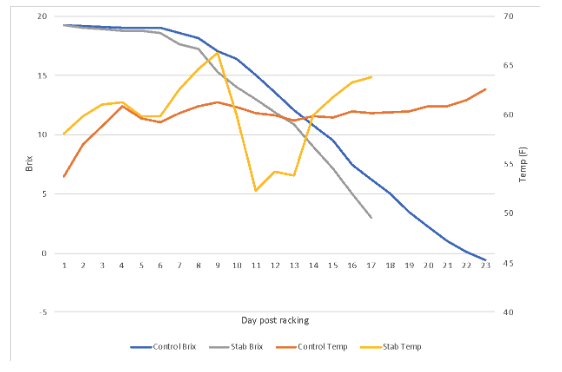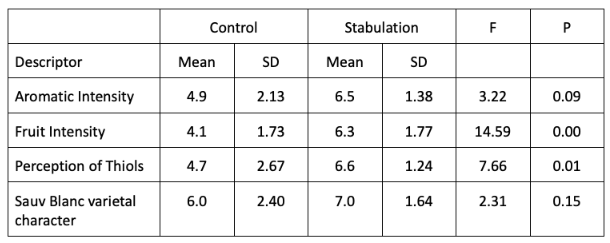Exploring the effects of stabulation in Sauvignon Blanc (2020)
Nate Walsh and Kent Arendt
Walsh Family Wine
Summary
Sauvignon Blanc varietal character has come to be defined by the presence of thiols, odor active molecules present in very small concentrations that have aromas of grapefruit, boxwood and cat pee. One technique that has been shown to increase thiols in wine is stabulation, the anaerobic mixing of juice lees for several days. In this experiment, Sauvignon Blanc juice was stabulated for two days prior to settling. Resulting wine was compared to wine from the same juice produced without stabulation. In a triangle test of stabulated vs control wines, 10 out of 23 respondents were able to distinguish which wine was different, indicating the wines were not significantly different (Z=0.81, p= 0.21). Among responses from participants with correct triangle tests, the stabulated wine received significantly higher scores for fruit intensity and perception of thiols. Many other variables also contribute to the presence of thiols in the finished wine, including precursor availability, yeast strain, and oxygen exclusion during aging.
Introduction
Sauvignon Blanc is a grape variety producing high quality wines in several wine regions around the world, including Virginia. Stylistically, Sauvignon Blanc wines can range from mineral driven, barrel fermented styles of the French, fruity driven styles of Austria all the way to green/grassy style of New Zealand1. Polyfunctional mercaptans (aka thiols) have been identified as characterizing the fruity yet herbal characteristics of New Zealand style Sauvignon Blanc2. Though they are only present in low concentrations (they are measured in nanograms, which is 10-9 grams!), thiols also have very low detection thresholds2,5. Most often associated with Sauvignon Blanc descriptors such as broom, boxwood, cat pee, and grapefruit, this class of compounds has also been shown to be important in the varietal character of Chardonnay, Petit Manseng, Merlot, Cabernet Sauvignon and Cabernet Franc, and Rosé among others6. The Learn Section of the WRE website contains much more information on varietal thiols.
One way to increase the concentration of thiols in wine is to use juice stabulation. Stabulation is a technique of stirring juice lees for several days to increase the extraction of flavor precursors from the pulp. Originally developed in Provence for use in Rosé winemaking3, this technique has been shown to increase the aromatic extraction of thiol and ester precursors, which are significant contributors to fruit and floral aromas including apple, banana, pear, rose, and honey.
When considering stabulation, it is important to hand harvest good quality fruit to prevent microbial activity and protect juice from oxygen with inert gas or dry ice to prevent oxidation of thiols into odorless compounds. After pressing, lees are anaerobically stirred, often with CO2. Wine is kept very cold (0-2°C) to prevent fermentation, but low temperature also requires longer for extraction. After juice has been stabulated, it is allowed to settle before racking, warming, and inoculation4. Practically, stabulation also allows for sequential presses of fruit off a large vineyard as juice can be added to the tank over several days. The purpose of this experiment was to determine if juice stabulation could be used to increase aromatic complexity in Sauvignon Blanc.
Methods
Sauvignon Blanc was harvested on 8/28/20, an early pick to prevent any rot. Fruit was chilled for 18 hours then whole cluster pressed to a stainless steel settling tank with the addition of 30 ppm SO2 and 15 ml/ton Cinn-free. Before settling, 225 L of juice was racked to a stainless steel barrel for stabulation. Both tank and barrel were sparged with CO2 before transfer.
The control tank was chilled overnight then racked into a fermentation tank with an initial NTU of 26 corrected to 110 before the start of fermentation. Stabulation occurred in the stainless steel barrel stored in a refrigerated trailer. Anaerobic stirring occurred at 3, 16, 22, and 37 hours. Wine temperature dropped from 62°F to 47°F within the first 16 hours. After 37 hours, the stabulated juice was allowed to settle and was racked to another stainless steel barrel on 9/2/20 with an initial NTU of 69 corrected to 108 prior to inoculation.
With the exception of stabulation, all other cellar operations remained the same between treatments. Juice was inoculated with 0.15 g/L ICV Okay yeast. An additional 5 g/hL yeast was added to each batch on 9/5/21. Fermaid K was added in small doses (20 g/hL at a time) beginning the third day of noticeable Brix depletion and continued for 7 days for a total addition of 136 g/hL. Sugar (18 g/L) was added on the third day of active fermentation. At the completion of fermentation, wine was racked to stainless steel tank (control) or barrel (treatment) with the addition of 50 ppm SO2. An additional 40 ppm SO2 was added 2 weeks later.
Sensory analysis was completed by a panel of 23 wine producers. Due to restrictions put in place during COVID-19, sensory analysis was completed using shipped samples. Each wine producer received three wines in identical bottles, filled on the same day, each coded with random numbers. Two of the bottles contained the same wine while the third bottle contained the different wine. Participants were asked to identify which wine was different (a triangle test). There were four tasting groups with the unique wine in the triangle test balanced among the groups. Participants were then asked to score each wine on a scale of 0 to 10 for aromatic intensity, fruit intensity, perception of thiols, Sauvignon Blanc varietal character. They were also given open ended questions to describe the wines. Results for the triangle test were analyzed using a one-tailed Z test. Descriptive scores were analyzed using repeated measures ANOVA.
Results
Sauvignon Blanc was harvested on 9/29. Fruit chemistry is shown in Table 1. Both lots originated from the same press of juice. Turbidity after racking was adjusted to 110 NTU in the control and 108 NTU in the stabulated lot. Fermentation was similar for both treatments (Figure 1). The control showed a slightly longer lag phase. There were some temperature fluctuations in the stabulated lot. The stabulated lot was in a stainless steel barrel with chilling in a reefer truck rather than a glycol fitted tank (control). Finished wine chemistry was very similar between treatments (Table 2).
In a triangle test of stabulated wines, 10 out of 23 respondents were able to distinguish which wine was different, indicating the wines were not significantly different (Z=0.81, p= 0.21). Among responses from participants with correct triangle tests, the stabulated wine received significantly higher scores for fruit intensity and perception of thiols. There were no significant differences in scores for aromatic intensity and sauv blanc varietal character (Table 3).
Table 1: Juice chemistry for Walsh Family Sauvignon Blanc (in-house data)

Figure 1: Fermentation kinetics for two treatments of Walsh Family Sauvignon Blanc (in-house data)

Table 2: Finished wine chemistry for two treatments of Sauvignon Blanc (ICV labs)

Table 3: Statistical analysis for descriptive scores from blind sensory analysis of cofermented Sauvingnon Blanc

References
(1) Green, J. A.; Parr, W. V.; Breitmeyer, J.; Valentin, D.; Sherlock, R. Sensory and Chemical Characterisation of Sauvignon Blanc Wine: Influence of Source of Origin. Food Research International 2011, 44 (9), 2788–2797.
(2) Benkwitz, F.; Tominaga, T.; Kilmartin, P. A.; Lund, C.; Wohlers, M.; Nicolau, L. Identifying the Chemical Composition Related to the Distinct Aroma Characteristics of New Zealand Sauvignon Blanc Wines. American Journal of Enology and Viticulture 2012, 63 (1), 62–72.
(3) Masson, G.; Schneider, R. Key Compounds of Provence Rosé Wine Flavor. Am J Enol Vitic. 2009, 60(1), 116–122.
(4) Report | ARC by Laffort.
(5) Jackson, R. S. Wine Science: Principles and Applications, 4 edition.; Academic Press: Amsterdam, 2014.
(6) Tominaga, T.; Baltenweck-Guyot, R.; Gachons, C. P. D.; Dubourdieu, D. Contribution of Volatile Thiols to the Aromas of White Wines Made From Several Vitis Vinifera Grape Varieties. Am J Enol Vitic. 2000, 51 (2), 178–181.
(7) Ting, J. July 2019: Varietal Thiols in Wine. Winemakers Research Exchange, 2019.
